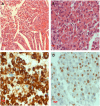AIP mutations in Brazilian patients with sporadic pituitary adenomas: a single-center evaluation
- PMID: 29074612
- PMCID: PMC5704447
- DOI: 10.1530/EC-17-0237
AIP mutations in Brazilian patients with sporadic pituitary adenomas: a single-center evaluation
Abstract
Aryl hydrocarbon receptor-interacting protein (AIP) gene mutations (AIPmut) are the most frequent germline mutations found in apparently sporadic pituitary adenomas (SPA). Our aim was to evaluate the frequency of AIPmut among young Brazilian patients with SPA. We performed an observational cohort study between 2013 and 2016 in a single referral center. AIPmut screening was carried out in 132 SPA patients with macroadenomas diagnosed up to 40 years or in adenomas of any size diagnosed until 18 years of age. Twelve tumor samples were also analyzed. Leukocyte DNA and tumor tissue DNA were sequenced for the entire AIP-coding region for evaluation of mutations. Eleven (8.3%) of the 132 patients had AIPmut, comprising 9/74 (12%) somatotropinomas, 1/38 (2.6%) prolactinoma, 1/10 (10%) corticotropinoma and no non-functioning adenomas. In pediatric patients (≤18 years), AIPmut frequency was 13.3% (2/15). Out of the 5 patients with gigantism, two had AIPmut, both truncating mutations. The Y268* mutation was described in Brazilian patients and the K273Rfs*30 mutation is a novel mutation in our patient. No somatic AIP mutations were found in the 12 tumor samples. A tumor sample from an acromegaly patient harboring the A299V AIPmut showed loss of heterozygosity. In conclusion, AIPmut frequency in SPA Brazilian patients is similar to other populations. Our study identified two mutations exclusively found in Brazilians and also shows, for the first time, loss of heterozygosity in tumor DNA from an acromegaly patient harboring the A299V AIPmut Our findings corroborate previous observations that AIPmut screening should be performed in young patients with SPA.
Keywords: AIP; germline mutations; sporadic pituitary adenomas; tumor suppressor gene.
© 2017 The authors.
Figures



Similar articles
-
High prevalence of AIP gene mutations following focused screening in young patients with sporadic pituitary macroadenomas.Eur J Endocrinol. 2011 Oct;165(4):509-15. doi: 10.1530/EJE-11-0304. Epub 2011 Jul 13. Eur J Endocrinol. 2011. PMID: 21753072
-
Clinical characteristics and therapeutic responses in patients with germ-line AIP mutations and pituitary adenomas: an international collaborative study.J Clin Endocrinol Metab. 2010 Nov;95(11):E373-83. doi: 10.1210/jc.2009-2556. Epub 2010 Aug 4. J Clin Endocrinol Metab. 2010. PMID: 20685857
-
Landscape of Familial Isolated and Young-Onset Pituitary Adenomas: Prospective Diagnosis in AIP Mutation Carriers.J Clin Endocrinol Metab. 2015 Sep;100(9):E1242-54. doi: 10.1210/jc.2015-1869. J Clin Endocrinol Metab. 2015. PMID: 26186299 Free PMC article.
-
AIP mutations and gigantism.Ann Endocrinol (Paris). 2017 Jun;78(2):123-130. doi: 10.1016/j.ando.2017.04.012. Epub 2017 May 5. Ann Endocrinol (Paris). 2017. PMID: 28483363 Review.
-
Mutations of the gene for the aryl hydrocarbon receptor-interacting protein in pituitary adenomas.Horm Res. 2009;71(3):132-41. doi: 10.1159/000197869. Epub 2009 Feb 3. Horm Res. 2009. PMID: 19188737 Review.
Cited by
-
AIP and MEN1 mutations and AIP immunohistochemistry in pituitary adenomas in a tertiary referral center.Endocr Connect. 2019 Apr;8(4):338-348. doi: 10.1530/EC-19-0027. Endocr Connect. 2019. PMID: 30822274 Free PMC article.
-
MicroRNA in Acromegaly: Involvement in the Pathogenesis and in the Response to First-Generation Somatostatin Receptor Ligands.Int J Mol Sci. 2022 Aug 4;23(15):8653. doi: 10.3390/ijms23158653. Int J Mol Sci. 2022. PMID: 35955787 Free PMC article. Review.
-
Clinical Relevance of Genetic Analysis in Patients With Pituitary Adenomas: A Systematic Review.Front Endocrinol (Lausanne). 2019 Dec 10;10:837. doi: 10.3389/fendo.2019.00837. eCollection 2019. Front Endocrinol (Lausanne). 2019. PMID: 31920960 Free PMC article.
-
The clinical and therapeutic profiles of prolactinomas associated with germline pathogenic variants in the aryl hydrocarbon receptor interacting protein (AIP) gene.Front Endocrinol (Lausanne). 2023 Aug 29;14:1242588. doi: 10.3389/fendo.2023.1242588. eCollection 2023. Front Endocrinol (Lausanne). 2023. PMID: 37711900 Free PMC article.
-
A Brief Overview of Molecular Biology in Pituitary Adenomas with a Focus on Aggressive Lesions.Int J Mol Sci. 2025 Apr 15;26(8):3717. doi: 10.3390/ijms26083717. Int J Mol Sci. 2025. PMID: 40332351 Free PMC article. Review.
References
-
- Gadelha MR, Trivellin G, Hernández Ramírez LC, Korbonits M. Genetics of pituitary adenomas. Frontiers of Hormone Research 2013. 41 111–140. - PubMed
LinkOut - more resources
Full Text Sources
Other Literature Sources
Miscellaneous

